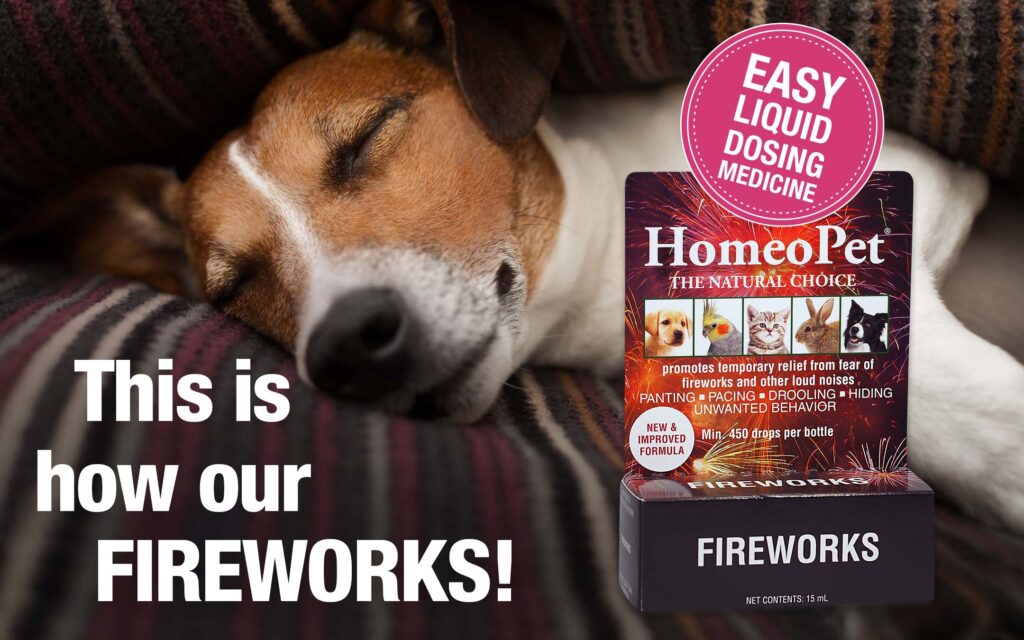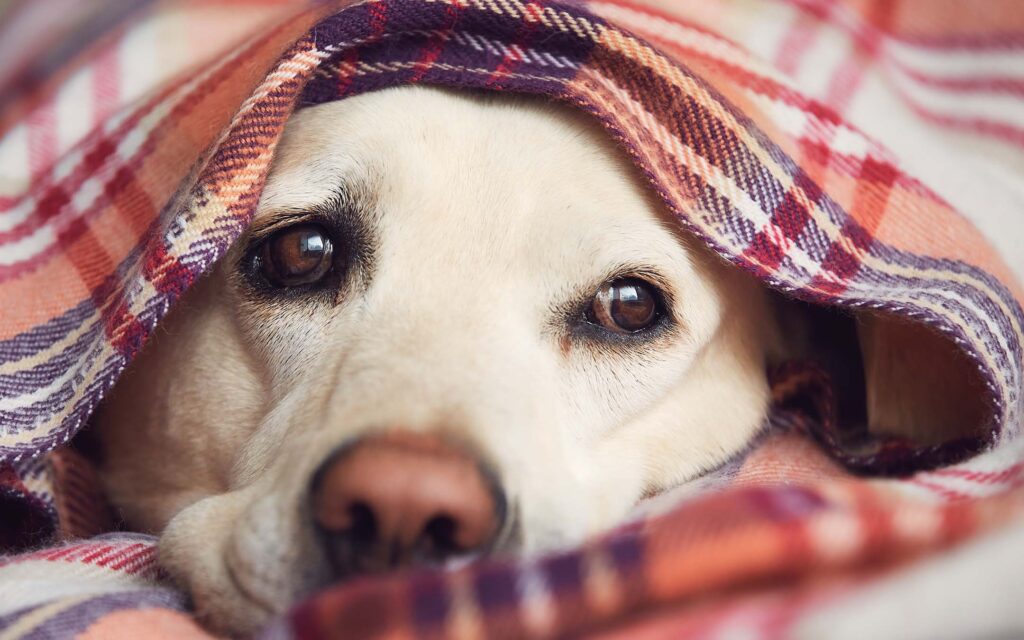No products in the cart.
Behavioral Issues In Pets
Noise phobia in dogs
How to help your dog cope and remain calm in stressful situations
It’s a familiar scenario for all too many of us. A sudden, loud noise – fireworks, thunder, gunshots bird scarers or even the vacuum cleaner or garbage truck down the block – causes your dog to react in panic. He or she may in response bolt so far as to get lost, run and seek a quiet place to hide or run to you seeking comfort. He may shake, tremble, drool and pant, embark on a bout of excessive barking or whining or may suddenly urinate or defecate indoors. In extreme cases, the ensuing panic may even cajuse aggressive behavior. None of these reactions are desirable, for you or for your dog. Noise phobia in dogs is relatively common and can be a source of great distress. A reaction that can develop in dogs of all ages, what may start as an acceptable short-term fear can in some cases generalize to other situations and develop into a full-blown phobia.
What causes Noise Phobia in dogs?
Most dog anxiety disorders seem to develop between the ages of 12 and 24 months and can worsen, if left untreated, as the dog matures socially. Puppies that have insufficient exposure to a variety of normal stimuli during their first four months of life are at a much higher risk of being overly fearful as adults. It can also be a learned behavior from a dog who is already noise phobic. It is also known that if a dog reacts to one noise, he is likely to react to other noises. For example, if your dog overreacts to thunderstorms, he is more than likely that he will respond similarly to fireworks. Noise phobias can also develop in your dog’s later years, possibly in response to exposure to an extremely frightening situation, such as being in a house affected by a severe thunderstorm, hailstones, a tornado or being in a car accident. It’s important to also bear in mind that your dog’s noise phobia could be related to his health, as any illness or pain may increase a dog’s sensitivity to noise and lower his threshold for anxiety and fearfulness.
Fear, anxiety or phobia?
While you might think they are the same thing, fear, anxiety, and phobia are actually quite different. Fear is a physiological, emotional and behavioral response to animate or inanimate things that pose a threat of harm. Fears are natural, acceptable and even desirable and fearful reactions can help keep your pet safe in potentially dangerous situations. Anxiety is a persistent fear or apprehension of something that is not present or imminent. Many animals suffer from a heightened state of anxiety and it’s important to try to find a solution for anxiety or stress in our pets. (link to previous blog article – Solutions for Anxiety and Stress in our Pets) And finally, there are phobias: extreme, persistent fears of a stimulus, such as a thunderstorm or nearby fireworks, that is entirely out of proportion to the level of threat it poses.
How we can make it worse
While our natural instinct may be to comfort and soothe our dog at times of distress, this may actually be counterproductive. To your dog, petting is a reward, so petting an overreacting dog in an attempt to comfort him or her may inadvertently confuse him as well and reinforce his anxious behavior. And for some dogs, being petted during a phobic episode is just one more anxiety-producing element in his environment.
So, what should you do?
While fear is a normal reaction, it’s important to be observant and be aware that some early intervention can help stop the problem getting worse and generalizing to other situations. Rather than take action that could inadvertently reinforce anxious behavior, try simply observing your dog during a fearful episode and see what you can do to calm him.
Safe den – Many dogs like to go somewhere dark and cosy when scared. Try moving your dog to a quiet, dark room in the house and either leave him alone there to self-soothe (as long as he’s not frantic), or stay quietly with him. A silent, still environment can often provide relief. Another option is to place several layers of blankets over a kennel or transport crate, or even a table that your dog is already accustomed to, to increase the noise-muffling effect. Your dog will need to be trained to find this place a safe haven with treats, chews, toys and he should ideally feel safe enough to take naps there, so this is a good approach to take early on if you think your dog is starting to develop a noise phobia. Alternatively, if your dog already has a bolt-hole, such as under the bed, just work on making it even more noise-proof and comfortable.
Background noise – If a nearby July 4th Halloween or Guy Fawkes fireworks display is the stimulus, it may be difficult to provide quiet! A noisy bathroom fan can provide great white noise to mask fireworks. Calm soothing music (check out www.musicmypet.com or simply search for ‘pet music’ on YouTube) may also both relax your dog and drown out distressing noises, as can a radio or other comforting noise source your pet is used to, but if he is already worked up, it may be too late to have an effect. It’s important to bear in mind that some dogs find any noise overstimulating, so experiment with what works for your dog. If you choose to try distracting music, try single instrument non-stimulating classical music, rather than heavy rock.
Pressure – you may find that putting gentle, continuous pressure on your dog acts to calm him. If he or she will allow it, try leaning gently on or against her, without petting or stroking. If this is helping, you’ll feel his muscles start to relax. If instead she seems to grow more anxious, this isn’t a technique that will be helpful for him, so don’t force it. If your dog does respond well to pressure, there are wraps available that many pet owners and veterinarians find extremely helpful. For some pets in thunderstorms, a duvet or blanket in a metal rather than a plastic bath can reduce the static electricity component.
De-sensitization – if you realise your dog is starting to develop a noise phobia for discrete sounds such as the vacuum cleaner, systematic desensitization and counterconditioning can be very effective. Find a recording online of similar frightening sounds – such as traffic or white noise – and play the sound at a low volume, gradually increasing intensity over time, whilst always making sure to stay below the threshold that causes your dog to become anxious. Accompany this situation with a high value reward such as food, play, or petting and you could be well on your way to reducing your dog’s stress reaction. However, desensitization doesn’t work well for certain noise phobias, such as thunderstorm phobia since storms are multisensory. While it may be possible to desensitize your dog to the sound of thunder with the help of a recording, he will still be nervous with the sound of wind, flashes of lightening, rain, pressure change, the static electricity in the air…
Essential Oils – Frankincense, Sandalwood and Violet Leaf are essential oils that are primarily effective for anxiety. Simply put in a vaporiser, in a bowl of water, or on a handkerchief and allow your dog to inhale the scent. Secondary calming oils can also be helpful, such as Rose Otto for past traumatic events, or Angelica Root can be helpful in circumstances as hormone loss from neutering can compound noise phobia in some dogs.

Natural relief – we’ve had huge success over the years with our natural HomeoPet Fireworks remedy – specifically formulated by vets to provide relief from stress and anxiety caused by thunder, fireworks and loud noises such as gunshots. This non-sedating liquid offers fast acting relief from restlessness, anxiety and unwanted behavior. For acute (sudden onset) cases such as a nearby accident with sirens that cause your dog to panic, simply dose every 15 minutes, up to 4 doses. For cases that are not acute (chronic long-term problems), one dose 3 times daily is sufficient and if you are aware of an upcoming stressful situation (such as before a fireworks display), this is often best started 5-7 days prior. Once a response is seen, administration should be reduced to 2 times daily and eventually once daily and then discontinuing use until needed again. HomeoPet Fireworks may also be applied to a handkerchief in a similar way to essential oils above, and your dog simply allowed to inhale the vapour.
If your dog’s anxiety is specifically related to storms, HomeoPet Storm Stress (US only) is a great option as it promotes calm in pets exhibiting fear from thunderstorms, wind, hurricanes and tornadoes. If your pet is restless, anxious or exhibits unwanted behavior during storms, this fast acting liquid can be given every 15 minutes, up to 4 doses. In acute cases, the doses can be given every 5 minutes up to 6 doses, until a response is seen.
Noise phobia in dogs quick check list
- Always be observant as to your dog’s behavior so you can recognize when a justifiable fear is becoming a potential long-term problem that requires action.
- If you recognize that your dog is developing a noise phobia, make sure you’re not rewarding his fear and anxiety.
- Provide your dog with a dark, quiet place to escape, or provide soothing music / background noise that will help to block out loud noises.
- Do not punish your dog for destructiveness, barking, or soiling that is done out of panic as this will only increase anxiety and make the problem worse.
- Provide your dog with natural relief with a product such as HomeoPet Fireworks.
If your dog (or any animal for that matter) suffers greatly from noise phobia and you have any questions, please feel free to contact our pet care team. They’d be delighted to answer any questions relating to HomeoPet Fireworks and natural approaches to pet health and keeping your animals calm, safe and happy.





